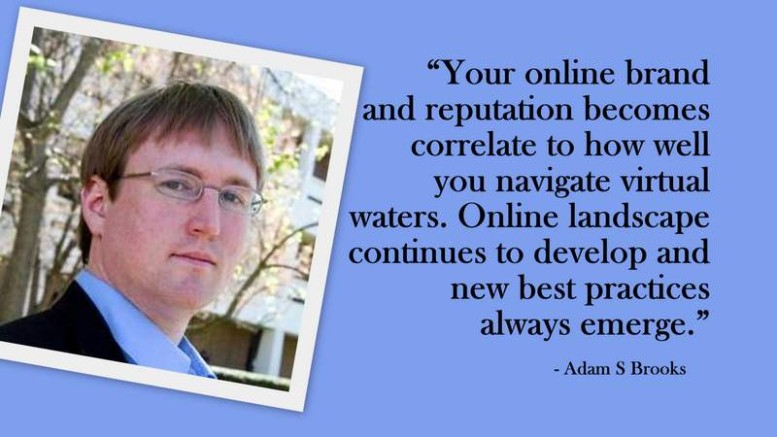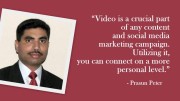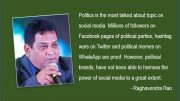I have frequently been called upon to consult with organizations and professionals on how to safely and effectively navigate the changing currents of online communications. Your online brand and reputation becomes correlate to how well you navigate these virtual waters. These five best practices and fundamentals apply to most forms of online communications and publishing whether it be a social service like Facebook, an online blog, or a customized website.
1. Purposeful Publishing
Puppies are cute. Many people want a puppy until it pees on their valuable rug, chews their shoes, incurs a large unexpected veterinary bill, or is no longer a cute little puppy. The newness wears off. The same can be said for online publishing and social media presences. It’s an exciting new thing for many people, but a quality presence takes time and work. It’s an investment.
Contrary to some popular practices, online publishing should be purposeful and sustainable. Before you launch into a project, it’s time to pause and plan a bit. Why do you want a presence? What are your goals? How do you define success? If ten million people go gaga over something that you publish, what should happen from that momentum to make it a success? How would you convert virtual success to tangible benefit? Certainly, narcissism can have its place online (thanks @KanyeWest), but I like to think there can be much more to it. What are your standards? How promptly will you respond to questions? How often will you publish?
2. Targeting Your Audience
With so much content being produced and distributed, the Internet has become an evolving stream of consciousness. There are so many options and distractions to compete with. In attempting to reach everyone, you will likely reach no one at all. The key is clearly identifying your audience and targeting your content to them. With a clear audience in-mind, it is much more attainable to target their demographics, their interests, their habits, and even the online services that cater to them. For example, if I am targeting working professionals, am I better served focusing on Facebook or LinkedIn? If I want to reach teens, should I invest more heavily on Twitter, Instagram, or something else newer and cooler? If I want to target those in the Charlotte community, what hashtags are most applicable? All of these questions can be readily answered through a little online research ONCE you have identified your specific targets.
3. Maintain a Content Discipline
Perhaps the greatest challenge is consistently coming up with interesting content that provides value to your audience. One of the great things about current publishing practices is that there are so many options; audio podcasts, photos, videos, blog articles, memes, quotes, infographics, etc. Consistently publishing great content attracts consistently great online users.
Writing a long article every other day is time-consuming work. Depending on your goals, it may be easier and just as valuable to consistently publish visual content such as photos, videos, or memes. Also remember that there’s tons of great content being produced (your included) that’s begging for someone to highlight it. For example, find an interesting online article or video that is relevant to your audience and package it up with some commentary so that it can be presented from your perspective to your users. Be sure to cite the source, link to the full resource, and do not to steal their property by reproducing it (a copyright violation). I often refer to this as “reheating.” The Huffington Post does this masterfully and Facebook lives for it. Ask yourself, “If I were a new user viewing this, what would I like to see?” If you don’t know for sure, ask your target audience. The growing trend is to focus on small bite-sized chunks of content. Yes, it’s the A.D.D. geek generation at work here, but there is research that supports the microcontent and microlearning models.
You may have heard the term “viral” which generally refers to content that is easily and (hopefully) rapidly shared. In sharing it, the content is spread from one person to another much like a virus. The math is pretty clear, bite-sized content + easily sharable = Win! I will add to this that content must be actionable with specific next steps such as a link to click, a question to respond to, or a statement to share it. Bite-sized content + actionable + sharable = Level Up!
4. Utilized Planned Publishing
When you release content is equally as important to its success as product placement is to merchandise in a store. If I publish amazing content at 3 a.m., it is likely that fewer of my target audience will be online at that time to see it. It’s not completely dead, but unless I’m trying to reach users who are online at that time, it’s not optimal. The sweet spots for releasing content are generally in the early morning, lunch time, and after work. These are the timeframes when more users check their messages and for updates from online communities. If you are attempting to reach an audience in a specific geographic area, just be sure that you adjust your release times to align with their timezone.
Let’s be also be honest about our lifestyles and availability to push out content. The 24-7-365 nature of media has a way of taking over and it’s impossible to be everything to everyone all of the time. At 6 p.m. you are at the grocery store. This is simultaneously a peak time for online users to view content. What should you do? Using your smartphone, it’s easy enough to draft and post a quick update, but have you really given any thought to what it should contain? If there’s great timely content to share, let’s use it. If not, let’s not rush into things and risk a blunder. Life and media goes on with or without you. Wouldn’t it be great if you could plan campaigns and schedule the release of quality content to present when it’s most useful to your audience? You aren’t alone in this need and some tools do exist to help with this. My personal favorite is Hootsuite (hootsuite.com). Hootsuite allows you to draft messages, even bulk upload a spreadsheet of messages, and schedule them to release according to your needs. It works with the most popular social media services including Facebook, Twitter, LinkedIn, Google+, and even WordPress blogs. Another newer tool worth checking-out is Latergramme (latergram.me) which provides a greater depth of Instagram functionality than even Hootsuite. Both of these services provide a free basic account!
5. Positive Responsiveness Counts
In a world of instant on-demand answers, Internet users are often impatient. Can we really blame them? The perceived anonymity of the Internet paired with the lack of inflection and visual cues, online communication can easily and unnecessarily escalate. Your role is remain a brand evangelist by demonstrating value. Whether the brand is a company or your own personal identity, this is the role that you play. This value is conveyed by responding promptly and positively to needs. You’ll catch more e-flies with honey than with vinegar. Before engaging in any heated online conversations, pause to reflect on the 10/10/10 rule. How will we feel about it 10 minutes from now? How about 10 months from now? How about 10 years from now? Respond to them in a timely manner with a positive, supportive tone. Users love prompt solutions. The audience may not always be right, but they should always be respected. Take any heated conversation or disagreement offline. Online drama easily snowballs out of control.
Conclusion
These are but five core principles for effective online communications and publishing from many that could be presented. The online landscape continues to develop and new best practices always emerge. How well do you represent your brand and provide value to others online? If you have additional tips or tricks to share with others, please Tweet to @adambrooks.









Be the first to comment on "5 Best Practices for Effective Online Communications and Social Media"